- Excavation and General Survey >
- Kaman-Kalehöyük >
- 27th Excavation
Kaman-Kalehöyük
Dr. Sachihiro Omura Director, JIAA
27th Excavation and Survey in Kaman-Kalehöyük Finished
Kaman-Kalehöyük Excavation Site
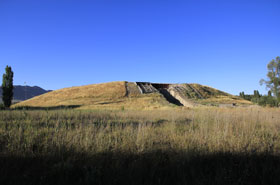
Picture: Kaman-Kalehöyük Excavation Site
The excavation site is located on the side of Ankara-Kayseri old highway, 100km south east of Turkish Republic. It is trapezoidal shape of which diameter is approx. 280m and height is 16m, it is a middle size site in Anatolia (Picture 1). In 1985, a preliminary survey was exercised and approx. 240,000 items of fragments of earthenware, iron slag, earthen potteries, and so forth were collected. Among those collected items, 10% of fragments of earthenware were analyzed and revealed that there are approx. 5500 years of culture involved in the Kaman-Kalehöyük.
Full-scale excavation and survey commenced in 1986 and continued up till now. The objective of the excavation and survey in this site is to “compile cultural stratigraphy”. In other words, this work is to make out a chronological table of Kaman-Kalehöyük. “Cultural stratigraphy” and “chronological table” are the very basic materials of historical study and archaeology.
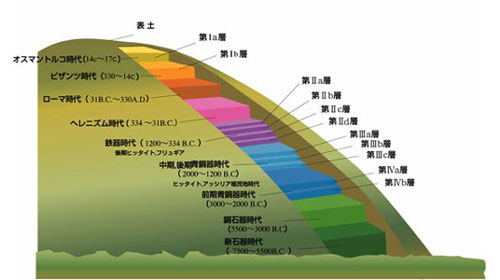
Figure 1: Schematic Depiction
There are 4 cultural layers already identified in the excavation and survey till now. The found cultural layers are the layer I – Ottoman Empire Period, the layer II – the Iron Age, the layer III – the Middle to Later Bronze Age and the layer IV – Early Bronze Age. According to the excavated relics and styles of architectures, the layer I is divided into the Ia layer and the Ib layer, the layer II is divided into the IIa layer, the IIb layer, the IIc layer and the IId layer, the layer III is divided into the IIIa layer and IIIb layer, the layer IV is divided into the IVa layer and the IVb layer. As the layer V the Copper and Stone Age and as the layer VI Neolithic Period would be identified in the up coming excavation and survey (Figure 1).
Progress of the 27th Excavation and Survey in Kaman-Kalehöyük
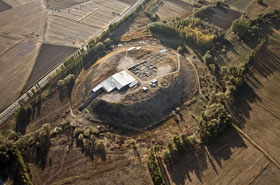
Picture 2: Kaman-Kalehöyük Excavation Site
The 27th excavation and survey in Kaman-Kalehöyük commenced preparation of excavation in latter June, full-scale excavation and survey started early July and in early September the excavation and survey finished. The other day the site was photographed with a digital camera mounted on a balloon (Picture 2). The provisional roofs to protect the excavated architectural remains were put and finished on 2nd of December.
Mr. Süleyman Tunç, a curator of the Kırşehir Archaeological Museum was dispatched to the excavation and survey site as an inspector by the Department of Archaeology of the Ministry of Culture and Tourism. The Kırşehir Archaeological Museum is not far from Kaman-Kalehöyük excavation site and Mr. Süleyman has been to the excavation site number of times and consequently he could get into the people of the camp soon after his arrival. Employment procedures started on 24th June and surprisingly there came much more applicants than expected.
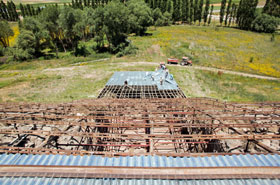
Picture 3:Removal of Protection Roofs on the North Trench
The protection roofs which were put after excavation and survey last year finished were removed from 25th June through to beginning of July. First the roof on the South Trench was removed and cleaning in the excavation sectors was commenced. As soon as removal of the South Trench was done, removal of the roof on the North Trench was commenced on 2nd of July (Picture 3). Mainly the protection roofs on the sectors IV through to IX in the North Trench where excavation would be exercised were removed this season. Technically removal of only these roofs was not possible and the protection roofs on the sectors XV through to XX which are both sides of sectors IV through to IX were to be removed.
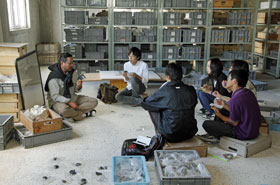
Picture 4: Archaeology field course
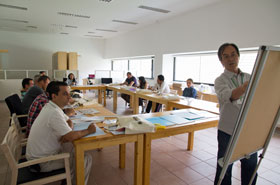
Picture 5: Museology field course
The architectural remains in both excavation sectors that were identified last year were as good conditions as the work last year finished probably because of the protection roofs. Parallel with the excavation and survey, a field course for archaeology was conducted. (Picture 5)
The Architectural Remains in the North Trench
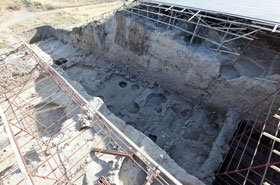
Picture 6: The North Trench
As mentioned already, excavation and survey in the sectors V through to IX were exercised in the North Trench (Picture 6). The objective of the excavation and survey in the North Trench in this season was to identify the Intermediate Period of the IVa layer and the Early Bronze Age in the IVb layer. In these excavation sectors, the architectural remains of the Assyrian Colony Period running north to south in the IIIc layer were identified and the survey last year and year before concentrated on the removal of these architectural remains (Picture 7). Partly the architectural remains of the IIIc layer, the Assyrian Colony Period were removed and the architectural remains of the Intermediate Period of the IV layer were clearly identified in the sectors V through to VI.
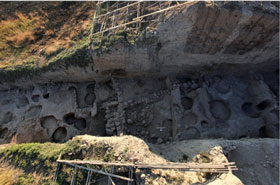
Picture 7: The North Trench
The peculiarity of the excavated relics from the IVa layer can be seen on the potteries. As potteries in the Intermediate Period, there are both ones made with wheels (Picture 8) and hand-twisted ones (Picture 9). The hand twisted potteries are considered to be inherited from the IVb layer, the Early Bronze Age and the hand twisted potteries are found in the IVa layer. The wheel-made potteries are inherited to the IIIc layer, the Assyrian Colony Period and the similar items can be seen in the IIIb layer, the cultural layer of the Old Hittite Kingdom. On the other hand the number of hand twisted potteries decrease drastically.
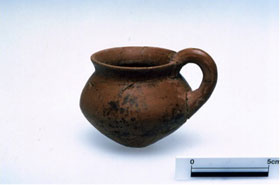
Picture 8: Pottery (Wheel made)
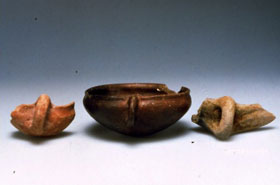
Picture 9: Pottery (Hand Twisted)
The architectural remains in the IIIc layer running north to south on the east side of the sectors V through VI are found to have been burnt down several times through the excavation and survey till now. The peculiarity of the architectural remains of the Assyrian Colony Period is the dug down style. The dug out areas must be the layer of the Assyrian Colony Period or former layers. In this season, remaining architectural remains of the IIIc layer were removed partially and by doing this the dug out remaining structures were identified. The identified remaining structures are floors only and they were burnt and carbides and many fragments of potteries were found on them. There are some fragments of potteries which have peculiarity of the Early Bronze Age among those items. However, the architectural remains belonging to the floors showing stable planning have not been identified.
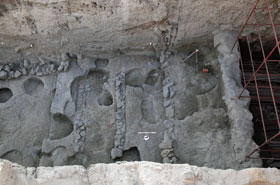
Picture 10: The Sector V in the North Trench
The stone wall in the IIIc layer running east to west was removed in the excavation and survey in the sector V. Several times there laid pavements with pebbles and fragments of earthenware on the space between these stone walls and the architectural remains with stone walls running north to south identified in the sectors V through to VIII. The paved road was laid alongside of the stone walls running east to west and was used for a long period of time. Where the stone walls running east to west were removed, iron materials are found. The materials are analyzed in Japan. Outside of the stone walls running north to south was intensively dug down this season and there found stone work architectural remains just beneath the life surface which is outside of the architectural remains running north to south similar to the sector VI (Picture 10). To make the plan of the architectural remains clear there took place excavation, however, total plan of the remains was not made clear and only floors were identified. Judging from the stone work of the architectural remains and the excavated relics such as potteries, there are material differences from those from the IIIc layer where excavation and survey have been exercised. There is a possibility that the architectural remains could have the relationship with the architectural remains of the sector IV in the IVa layer in terms of the order of layers. The architectural remains of the sector V identified this season could be of the IVa layer, the Intermediate Period and further classification and analysis on the excavated relics have to be exercised. It is considered that observation to the east section has to be made next season.
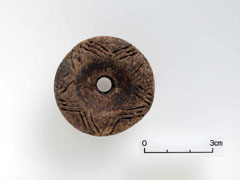
Picture 11: Spindle Wheel
The Excavated Relics from the North Trench
Many of excavated relics in the North Trench are potteries, bronze products and iron materials. There are painted potteries among them. Most of them are fragments and they are Alişar third style potteries and the Intermediate Period potteries many of which have been identified in the areas of central Anatolia, especially the area surrounded by the Kızılırmak river. On top of that the one which should be focused relic is the iron materials. They are lump of iron, iron slag and so forth. They are brought back to Japan having the clearance from the Ministry of Culture and Tourism of the government of Turkish Republic. They are being analyzed and when the results are available, report will be given. Other than those, earthen spindle wheels, bronze pins are excavated (Picture 11).
The Architectural Remains in the South Trench
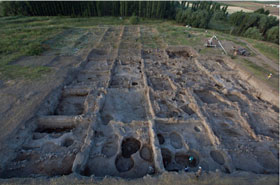
Picture 12: The South Trench
As mentioned, the excavation and survey in the South Trench was commenced in the beginning of July (Picture 12). Soon after the protection roofs were removed, excavation was commenced and the I layer, Ottoman Empire Period and the II layer, the Iron Age were investigated.
The excavation and survey in the I layer reminds us of the mark of well and from covering soil fragments of ceramics, iron slag, etc. have been excavated in many of the fragments of potteries. It is not clear yet whether this is the mark of well or not and further investigation has to be carried out.
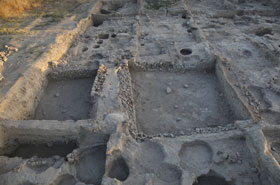
Picture 13: The South Trench: A Mark of a Storage
In the II layer, the IIa layer, the IIc layer and the IId layer which are of the Iron Age were intensively surveyed.
In the IIa layer, the architectural remains that must have been damaged when a mark of a well of the Ottoman Empire Period had been constructed were surveyed. Many of the architectural remains identified in the IIa layer in this season are stone walls. There were not ones that show plans clearly. There also found floors attaching to the stone walls, but any of them were not in good preservation conditions.
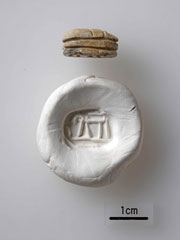
Picture 14: Seal
In the IIc layer, 10m x 10m wide and 2m deep rock work storage mark was identified (Picture 13). The reason it can be of the IIc layer is painted earthenware excavated in the mark of the storage. Previously there was another mark of storage identified east side of this mark of storage. How much of grain could be stored in these storages has to be clarified in the study from now on. There is a figure that the Hittite round storage could store grains for 3000 people. From this information the storage in the South Trench could store grains at least for 2000 people.
It has been identified that the houses in the architectural remains in the IId layer were repeatedly rebuilt at times of repeated fire. There are architectural remains in the North Trench as well, however, they were not rebuilt so many times as the ones in the South Trench. From this fact, in the time of the IId layer the center of the settlements were located in the South Trench areas rather than the North Trench areas, i.e. south part of the hill. In comparison with the other ages, any of the architectural layers in the South Trench are burnt. Meanings of this fact have to be clarified in the up coming study.
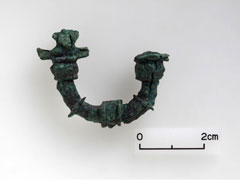
Picture 15: Fibula
Excavated Relics from the South Trench
There were potteries, bronze products, iron products, outfittings, seals and so forth were excavated in the excavation and survey in the South Trench (Picture 14). Many of fragments of painted potteries with deer paint of the Iron Age were found in the IIc layer. There also are bronze fibulae of the IIa layer were excavated (Picture 15). There identified much of iron slag in the IIa layer and there must have been iron production ateliers nearby.
Summary of 27th Excavation and Survey in Kaman-Kalehöyk
The excavation and survey this season could get into the IVa layer, which can be considered to be a large advance. The IVa layer is of the 3rd millennium B.C. to the beginning of the 2nd millennium B.C. and in this period, it is commonly accepted that Hittite who were Indo-European got into central Anatolia and got in touch with the culture of the Assyrian Colony Period. However, whether there are excavated relics that can be identified as Indo-European or not is a big issue. To clarify this matter the excavation sectors III through to VI have to be further excavated and excavated relics should be sorted and classified per the architectural layers and precise study has to be exercised. The IVa layer was identified in the sector III and a comparative study of the relics especially potteries from the architectural remains with the potteries from the sector IV and the sector V which was identified this season may bring up the clarify the differences between IVa layer and IVb layer. Such work will be exercised from the end of 2012 through to March of 2013.
Acknowledgements
The excavation and survey in Kaman-Kalehöyük has been supported by many of supporting bodies by ways of subsidies and aid money. We are grateful for all such supports extended to us and the following are names of bodies subsidized in 2012.
- Japan Society for the Promotion of Science
- Japan Keirin Association

- Sumitomo Foundation
- Foundation for Cultural Heritage and Art Research
- The Tokyo Club
- Japan Tabacco Inc.
Progress of the 27th excavation and Survey in Kaman-Kalehöyük (2012)
The excavation and survey commenced in early July in Kaman-Kalehöyük goes well. Central Anatolia was hit by heat wave end of July to early August, but there were no team members having health problems.
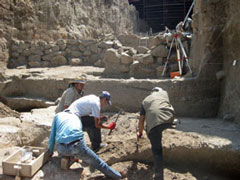
Picture 1: The North Trench
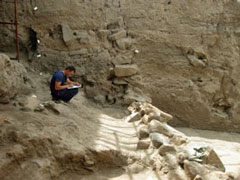
Picture 2: The North Trench
Excavation and survey has been going on in two excavation sectors, the North Trench and the South Trench. In these excavation sectors large and robust rock work architectural remains of the Assyrian Colony Period running north to south and attaching to them small paths which were paved with fragments of potteries and pebbles running north to south as well as east to west were identified. Over the years the architectural remains running north to south were removed for excavation and survey, but in this season the life surface which is outside of the architectural remains have been dug down. There are number of hand twisted earthenware among the excavated earthenware and it suggests that these excavation sectors are getting into the Early Bronze Age gradually.
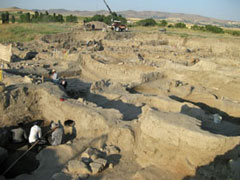
Picture 3: The South Trench
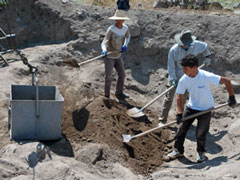
Picture 4: The South Trench
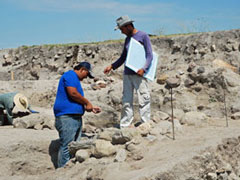
Picture 5: The South Trench
In the South Trench a large and rectangular rock work architectural remains which is assumed to be a grain storage is being excavated in the IIc layer. There are earthenware with deer patterned Alişar IV style found in the remains. Just beneath the architectural remains of the IIc layer, large number of architectural remains of the IId layer, the Dark Age have been found. Characteristically, most of them were burnt and the survey has been exercised following the layers of fire.
There have been much of materials including number of impressions of seal, potteries, iron materials and so forth of the Assyrian Colony Period have been excavated in the North Trench. There have been excavated bronze belt buckle, potteries, glass beads, bronze pins and so forth of the Iron Age in the South Trench. The excavation and survey are getting into the exciting part.
The 27th Excavation and Survey in Kaman-Kalehöyük (2012) Started
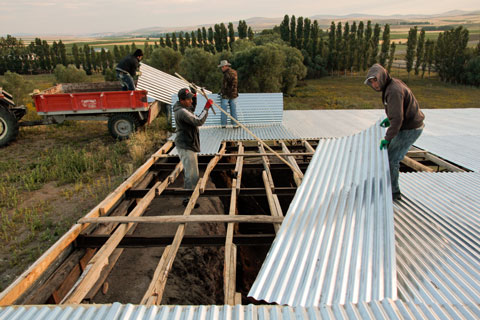
Removal of the Protection Roofs
The protection roofs which were put to protect the remains are removed as from 25th June as a starter of the 27th excavation and survey in Kaman-Kalehöyük (2012). The architectural remains excavated last year are preserved in very good conditions by virtue of the protection roofs. There were some collapse in the cross sections, but over all situation is good enough. After removal of the protection roofs excavation sectors were cleaned.
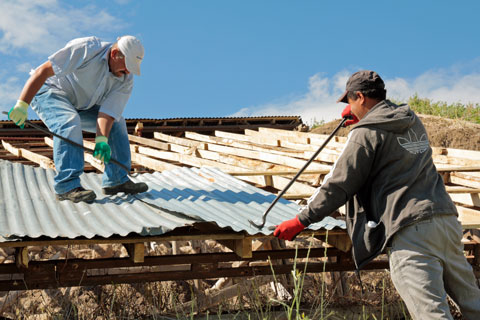
Removal of the Protection Roofs
Mr. Süleyman Tunç, a curator of the Kırşehir Archaeological Museum was dispatched by the Ministry of Culture and Tourism as an inspector and as soon as his arrival at the camp site, full scale excavation and survey started. Following the last season “compiling cultural stratigraphy” will be pursued this year. Especially the first quarter of the 2nd millennium B.C., the Assyrian Colony Period in the IIIc layer and the IVa layer of end of the 3rd millennium B.C. to beginning of the 2nd millennium B.C. will be intensively excavated. In the South Trench, the IIc layer of the end of the 9th to the 8th centuries B.C. and the IId layer located just beneath it will be intensively surveyed.
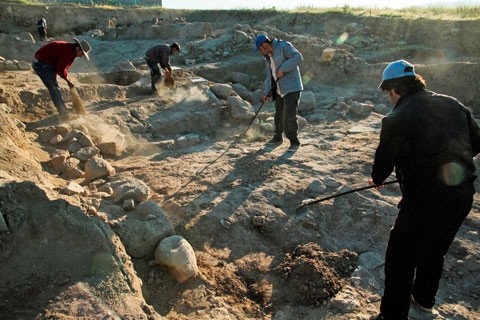
Cleaning Work
Putting protection roofs is subsidized by the Sumitomo Fundation.